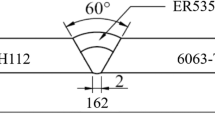Abstract
This work investigates heat transfer mechanism of aluminum resistance spot welding process. The main target is to determine thermal contact conductance and heat transfer coefficients for natural convection and thermal radiation at ambient air and forced convection inside the water-cooled electrodes. For this purpose, the heat transfer of hot sheets in a welding gun for aluminum alloys AA5182 and AA6014 is analyzed experimentally and numerically. The transient temperature field is measured by several thermocouples in a simplified experimental setup. Subsequent thermal-mechanical coupled finite element simulations of the experiments were used to calibrate the heat transfer coefficients. The heat transfer coefficient for natural convection and thermal radiation to ambient air is 13 \(\mathrm {\frac {W}{m^{2} K}}\) and the heat transfer coefficient for forced convection of electrode water-cooling is 25,000 \(\mathrm {\frac {W}{m^{2} K}}\). The results indicate that the thermal contact conductance can be assumed ideal for welding process. Additionally, the finite element model is validated by the measured and calculated dissipated heat due to forced convection. Finally, a sensitivity analysis is performed to compare the influence of maximum and minimum heat transfer coefficients of forced convection (water-cooling) on transient temperature field and dissipated heat of sample AA5182.












Similar content being viewed by others
References
Manladan SM, Yusof F, Ramesh S, Fadzil M, Luo Z, Ao S (2017) A review on resistance spot welding of aluminum alloys. Int J Adv Manuf Technol 90:605–634
Dilthey U (2006) Schweißtechnische Fertigungsverfahren - 1 Schweiß- und Schneidtechnologien, 3rd edn. Springer, Berlin
Phillips DH (2016) Welding engineering—an introduction. Wiley, New York
DVS-Merkblatt 2902-1 (2001) DVS-Merkblatt 2902-1: Widerstandspunktschweißen von Stählen bis 3 mm Einzeldicke - Übersicht
Karimi MR, Sedighi M, Afshari D (2015) Thermal contact conductance effect in modeling of resistance spot welding process of aluminum alloy 6061-T6. Int J Adv Manuf Technol 77:885–895
Khan JA, Broach K, Arefin Kabir AAS (2000) Numerical thermal model of resistance spot welding in aluminum. J Thermophys Heat Tr 14(1):88–95
Wan Z, Wang H-P, Wang M, Carlson BE, Sigler DR (2016) Numerical simulation of resistance spot welding of Al to zinc-coated steel with improved representation of contact interactions. Int J Heat Mass Tran 101:749–763
Greitmann MJ (2002) Grundlegende Untersuchung zur Kontaktsituation beim Widerstandspunktschweißen - Abschlussbericht. Forschungsvorhaben AIF-Nr. 12.617N / DVS-Nr. 4.023, Staatliche Materialprüfungsanstalt (MPA) Universität Stuttgart
Browne DJ, Chandler HW, Evans JT, Wen J (1995) Computer simulation of resistance spot welding in aluminum: part l. Weld J 74(10):339–344
Moshayedi H, Sattari-Far I (2012) Numerical and experimental study of nugget size growth in resistance spot welding of austenitic stainless steels. J Mater Process Technol 212(2):347–354
Luo Z, Yan F, Li Y, Bai Y, Yao Q, Tan H (2015) Numerical and experimental study on nugget formation process in resistance spot welding of aluminum alloy. Trans Tianjin Univ 21(2):135–139
Mirzaei F, Ghorbani H, Kolahan F (2017) Numerical modeling and optimization of joint strength in resistance spot welding of galvanized steel sheets. Int J Adv Manuf Technol 92:3489–3501
Wang J, Wang HP, Lu F, Carlson BE, Sigler DR (2015) Analysis of Al-steel resistance spot welding process by developing a fully coupled multi-physics simulation model. Int J Heat Mass Tran 89:1061–1072
Gupta OP, De A (1998) An improved numerical modeling for resistance spot welding process and its experimental verification. J Manuf Sci Eng 120(2):246–251
Kaars J (2017) Zur Thermomechanik des Widerstandspunktschweißens von Vergütungsstahl am Blechstoß mit Spalt. Dissertation, TU Chemnitz
Piott M, Werber A, Schleuss L, Doynov N, Ossenbrink R, Michailov V G (2019) Electrical contact resistance model for aluminum resistance spot welding. In: Sommitsch C, Enzinger N, Mayr P (eds) Mathematical modelling of weld phenomena 12, Verlag der Technischen Universität Graz, pp 711–728
Author information
Authors and Affiliations
Corresponding author
Additional information
Publisher’s note
Springer Nature remains neutral with regard to jurisdictional claims in published maps and institutional affiliations.
Rights and permissions
About this article
Cite this article
Piott, M., Werber, A., Schleuss, L. et al. A study of the heat transfer mechanism in resistance spot welding of aluminum alloys AA5182 and AA6014. Int J Adv Manuf Technol 111, 263–271 (2020). https://doi.org/10.1007/s00170-020-05650-x
Received:
Accepted:
Published:
Issue Date:
DOI: https://doi.org/10.1007/s00170-020-05650-x




